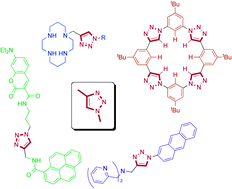Chemical sensors that incorporate click-derived triazoles
Abstract
Since the advent of click chemistry in 2001, the 1,4-disubstituted

* Corresponding authors
a School of Chemistry, The University of Sydney, Australia
b The Joseph Priestley Building, School of Biological and Chemical Sciences, Queen Mary University of London, Mile End Road, London, UK
Since the advent of click chemistry in 2001, the 1,4-disubstituted

 Please wait while we load your content...
Something went wrong. Try again?
Please wait while we load your content...
Something went wrong. Try again?
Y. H. Lau, P. J. Rutledge, M. Watkinson and M. H. Todd, Chem. Soc. Rev., 2011, 40, 2848 DOI: 10.1039/C0CS00143K
To request permission to reproduce material from this article, please go to the Copyright Clearance Center request page.
If you are an author contributing to an RSC publication, you do not need to request permission provided correct acknowledgement is given.
If you are the author of this article, you do not need to request permission to reproduce figures and diagrams provided correct acknowledgement is given. If you want to reproduce the whole article in a third-party publication (excluding your thesis/dissertation for which permission is not required) please go to the Copyright Clearance Center request page.
Read more about how to correctly acknowledge RSC content.
 Fetching data from CrossRef.
Fetching data from CrossRef.
This may take some time to load.
Loading related content
